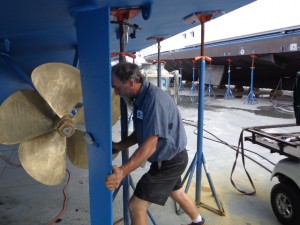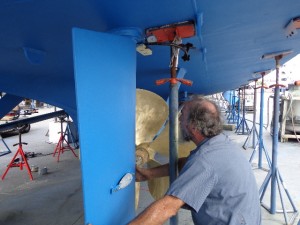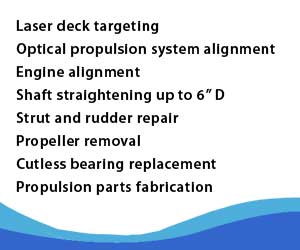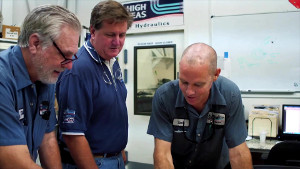Class ABS and Lloyds Rudder Bump Test
Vessels falling within this class are required to have a rudder bearing clearance inspection every five years. However, we find more and more often that surveyors are asking for this data every time the vessel is hauled. The good news is a rudder “bump” test will give sufficient information to avoid the cost of completely removing the rudders. The simple 15-minute test (which measures lower bearing wear) can be performed anytime a yacht is hauled. However, in order to minimize down-time, it is important the test be conducted as soon as possible after hauling to provide enough time for parts ordering and the completion of repairs if the test reveals excessive wear. Note, even if the inspection is done before the five-year survey, ABS and Lloyds requires a repeat examination during the survey. The most notable signs of excessive wear are vibration and leakage around the lip seals.
How the Test is Performed
A stanchion (usually a yard jack stand) is raised to the bottom of the vessel directory abeam of the rudder post to create a stationary benchmark. Using a dial gauge affixed between the post and stanchion, lateral pressure is applied to the bottom of the rudder flag to check for athwartship movement, the most common bearing wear is athwartship (not fore/aft), due to the greatest hydraulic forces. Rudder bearings come in a variety of flavors; bronze, cutlass, Thordon, Tides or other phenolic material. Acceptable wear varies based on the  material, but typically bearing wear which exceeds .030” (3/4mm) indicates excessive wear and must be replaced. The same test is performed after the stanchion is moved fore or aft of the post.
material, but typically bearing wear which exceeds .030” (3/4mm) indicates excessive wear and must be replaced. The same test is performed after the stanchion is moved fore or aft of the post.
When your surveyor asks for a “Rudder Bump Test” don’t worry – the test is fast, simple and painless. If you are in Lauderdale Marine Center we can knock it out on short notice.



 Click to watch the video of a day at High Seas Yacht Service.
Click to watch the video of a day at High Seas Yacht Service. Click to watch Marine Industries Association of South Florida video featuring Salty Jobs at High Seas Services.
Click to watch Marine Industries Association of South Florida video featuring Salty Jobs at High Seas Services.
Comments are closed.